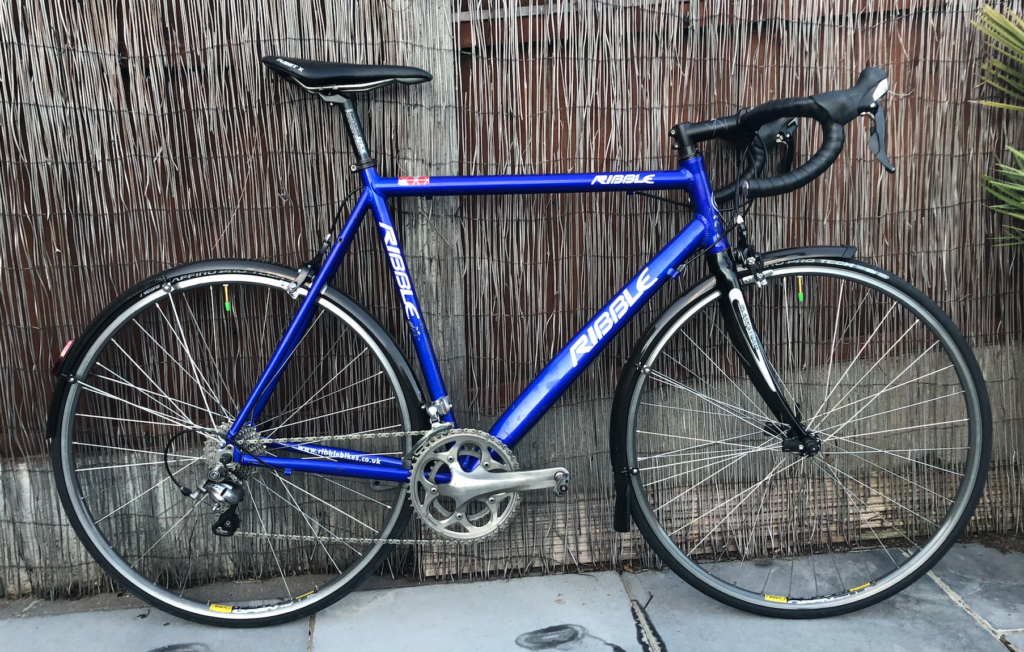We all know the old N+1 rule for bike ownership (N= the number of bikes you currently own) but…
Do You Really Need a Winter Road Bike?
For decades, many cyclists maintained a dedicated winter road bike—a rugged, weather-resistant “hack bike” they’d bring out only for cold, wet months. These bikes were often built with steel frames, rim brakes, narrow tires, and inexpensive components (or random old components found in the garage/shed), designed to endure winter’s toll. But with advancements in modern bike technology, the need for a separate winter bike has become far less pressing. Today’s road bikes can often handle winter riding with just a few adjustments, making a dedicated winter bike feel more like a luxury than a necessity.
Here’s a look at why technology like disc brakes, tubeless tires, electronic shifting, and weather-resistant materials makes modern road bikes capable of tackling winter conditions—no winter-specific bike required.

1. Disc Brakes: Reliable Stopping Power in Any Weather
One of the biggest reasons winter road bikes were popular in the past was the limitations of rim brakes. Not that there were any real options (other than rocking a Cyclo-Cross bike with Canti or V brakes). The main issue was around the wear on rims, wet conditions mixed with gravel, pad debris and other contaminants could very quickly become a grinding paste that would do its best to destroy your ‘good’ wheels!
Now, however, the adoption of disc brakes on road bikes has largely eliminated these issues. Hydraulic disc brakes, in particular, offer smooth, responsive braking that isn’t compromised by cold or wet conditions. This reliable braking performance allows many riders to confidently take their main road bike out in winter without worrying about trashing their good wheels!.
In short, disc brakes are a game-changer for winter riding, making separate winter bikes and even winter wheels unnecessary to a certain degree (I would still have doubts about using my best carbon rims through the winter though)!
2. Wider Tubeless Tires: Better Traction and Durability
Traditionally, road bikes were designed with narrow tires—typically 23-25mm wide—which were ideal for dry roads but could be treacherous in the wet or even worse when the roads were just damp. In the past, many riders would swap these tires for wider, sturdier ones on their winter bikes to improve grip and control in winter conditions – usually through the use of touring or cross bikes that allowed greater clearance for tyres.
However, today’s road bikes increasingly accommodate wider tires, often up to 28mm or even 32mm, which offer better stability and traction on wet or uneven roads. Many riders are now opting for tubeless tires, which allow them to ride at lower pressures for enhanced traction and control without the risk of pinch flats. Tubeless tires can also be more puncture-resistant, which is a huge advantage in winter when road debris is common.
Thanks to the rise of tubeless technology and wider tire compatibility on modern road bikes, you can now can simply equip your bike with winter-friendly tires rather than needing a separate winter bike. This adaptability is one of the key reasons that dedicated winter road bikes are becoming less necessary.
3. Weather-Resistant Frames and Components
In the days of rim brakes and narrow tires, steel was the material of choice in general and as we know, it doesn’t necessarily like grit, salt and water – therefore putting your top end Columbus or Reynolds tubed bike away for the winter and allowing an older, tougher bike to take the strain made total sense!
Today, however, frame materials and treatments have come a long way. Aluminum and carbon frames are naturally resistant to rust, making them far more resilient in harsh weather. Bearings, bottom brackets, and drivetrain components have also improved, with better seals and corrosion resistance, so they hold up better when exposed to winter conditions.
In other words, modern road bikes are designed with materials and components that are more durable, so you can ride them in winter without excessive worry about wear and tear. The need for a winter-specific bike has largely diminished, as most road bikes today are built to last through all seasons.
4. Electronic Shifting: Reliable in Cold and Wet Conditions
In the past, winter cycling was a nightmare for mechanical shifting. Cold temperatures, road salt, and moisture would make shifters and derailleurs stiff and unreliable. To work around this, winter bikes often used simpler drivetrains or older components that riders didn’t mind getting damaged.
Today, electronic shifting systems like Shimano Di2 and SRAM eTap have transformed the winter riding experience. Unlike mechanical systems, electronic shifting is sealed from the elements, and it performs reliably even in freezing or wet conditions. The precise, consistent shifting makes modern road bikes ready for winter, as riders no longer have to worry about cables seizing up or sluggish gear changes. This technology effectively reduces the need for a winter-specific drivetrain, making winter bikes a bit redundant.
5. Integrated Mud Guard Mounts and Lighting Options
Ever tried to turn up to a group ride in the winter without mudguards? You will only ever do it once, trust me!
Therefore winter road bikes were often equipped with mudguards to protect riders from water and slush thrown up by the wheels. Traditional road bikes didn’t have mounts for full-coverage guards, so you were forced to rig up makeshift solutions or settle for less effective clip-on guards, which could rattle and shift while riding.
Modern road bikes, however, often come with integrated mounts for guards, making it easy to add full coverage for winter riding. This integration allows riders to add and remove them as needed, so their main road bike can be fully winterised without much hassle. Additionally, advancements in bike lighting technology mean you can easily equip powerful, rechargeable lights to their road bikes for the darker winter days, ensuring they stay visible and safe.
It is also worth noting that the technology used on clip on guards has also improved massively meaning that they can now be used on most bikes fairly easily.
With today’s integration options, adding winter accessories like guards and lights to a regular road bike is easier than ever. This convenience has further reduced the need for a separate winter-specific bike.
Conclusion: Why a Dedicated Winter Road Bike Might Be a Thing of the Past
The advances in road bike technology over the past decade mean that today, we have a range of options to adapt our bikes for winter riding. Disc brakes, tubeless tires, electronic shifting, and weather-resistant materials have collectively transformed how we think about winter cycling. Today’s road bikes are better equipped for cold and wet conditions, allowing you to safely and comfortably use your main road bike throughout the year, without needing to invest in a separate winter bike.
While some riders may still prefer a “hack bike” for particularly harsh winters or salt-covered roads, for most of us (myself included), a modern road bike can now handle winter conditions with just a few adjustments.
As technology continues to improve, the line between “summer” and “winter” bikes will likely blur even further, making it possible to confidently cycle year-round with a single, adaptable bike.
If this post has struck a chord with you, the next post will be for you – as we will be looking at the best way to ‘winterise’ your bike to get the most from the upcoming seasons riding!
